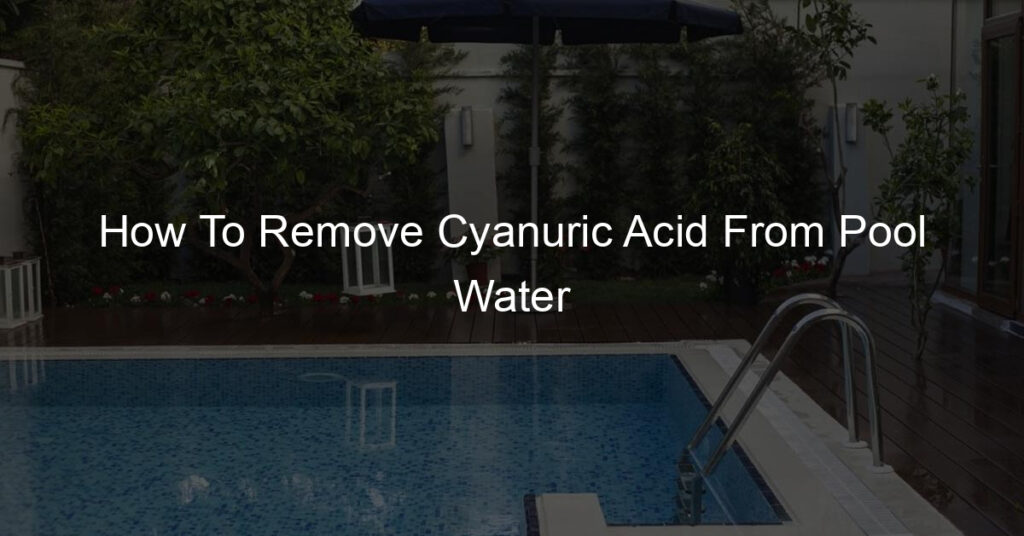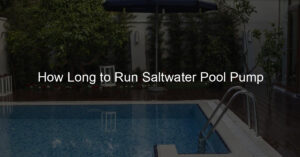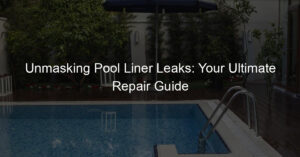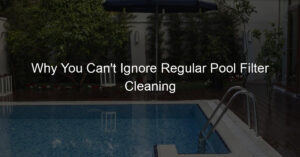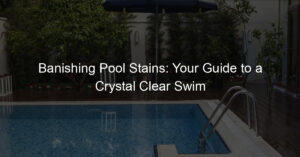Understanding the Role of Cyanuric Acid in Pool Water
Cyanuric Acid (CYA), also known as pool conditioner or stabilizer, plays a crucial role in maintaining the efficacy of chlorine in swimming pools. CYA acts as a buffer to protect the chlorine from the sun’s ultraviolet (UV) rays, thereby preventing rapid chlorine dissipation and helping the pool maintain its sanitizing power. In optimal amounts, Cyanuric Acid can extend the life of chlorine by up to 10 times, providing significant cost savings and ensuring a safe, clean swimming environment.
How Cyanuric Acid Levels Get Too High
Over time, the levels of Cyanuric Acid can build up due to regular additions of chlorine stabilizer, or by using chlorine products such as dichlor or trichlor that contain CYA. Furthermore, pool shock treatments can also contribute to an increase in CYA levels. It’s important to remember that while Cyanuric Acid doesn’t evaporate or dissipate like chlorine, it only leaves the pool if water is physically removed. Consequently, continued use of CYA-based products without appropriate water replacement can lead to accumulation.
Identifying the Signs of Excess Cyanuric Acid
Knowing the signs of excess Cyanuric Acid can save you from potential pool problems down the line. High CYA levels often result in what’s known as ‘chlorine lock’, where the chlorine becomes less effective, leading to cloudiness, algae blooms, and poor sanitation. You might also notice an unusually high chlorine demand, that is, you’re having to add more chlorine than usual to maintain the same level. Understanding these signs can help in timely detection and prevention of related issues.
Testing for High Cyanuric Acid Levels
Regular testing is crucial to maintain appropriate levels of Cyanuric Acid in your pool. You can use readily available testing kits or strips that measure not only the CYA levels but also other important parameters such as pH and chlorine levels. Additionally, digital testing devices or professional pool services can provide more precise measurements. If your CYA levels are consistently above 100 parts per million (ppm), it’s generally a sign that they’re too high.
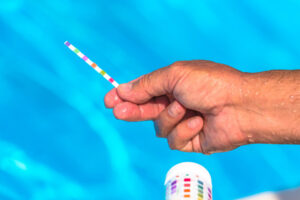
The Dangers of High Cyanuric Acid Levels
High Cyanuric Acid levels pose several risks. Primarily, it can cause the chlorine in the pool to become less effective, resulting in cloudy water and potential algae blooms.
This reduces the pool’s sanitation, creating a conducive environment for bacteria and other pathogens. Moreover, it can lead to calcium scaling on the pool surfaces and filtration system, which could eventually lead to costly repairs. Lastly, it can cause skin and eye irritation for swimmers.
Setting the Optimal Cyanuric Acid Level for Your Pool
The optimal level of Cyanuric Acid in your pool depends on various factors such as your geographical location, the amount of direct sunlight your pool receives, and local regulations. However, as a general rule, CYA levels should be between 30 and 50 ppm for optimal effectiveness. If you have a saltwater pool, the recommended CYA levels could be higher, usually between 70 and 80 ppm. Always refer to your pool manufacturer’s instructions or consult a pool professional for the best advice.
Basic Methods to Lower Cyanuric Acid in Pool Water
There are several basic methods to lower Cyanuric Acid levels in pool water. The most common one is dilution, which involves partially draining the pool and refilling it with fresh water. This reduces the concentration of CYA, bringing its levels down. Another method is using a CYA reducer product, which biologically decomposes the Cyanuric Acid into nitrogen and carbon dioxide gases.
These methods can be efficient but may require multiple applications or repetitions to reach optimal CYA levels. For instance, in cases of very high CYA concentration, you may need to drain and refill more than once, or use additional doses of CYA reducer.
Furthermore, it’s essential to test the water after each treatment to monitor progress and determine whether further action is needed. These basic methods are relatively simple and cost-effective, but they require careful management to be successful.
Be patient and persistent in your approach, and you’ll likely see gradual improvement in your pool’s CYA levels.
The Dilution Method: Using Fresh Water to Lower Cyanuric Acid
The dilution method is the most straightforward and cost-effective way to reduce CYA levels in your pool. This involves partially draining the pool and refilling it with fresh water, which dilutes the Cyanuric Acid concentration.
However, the effectiveness of this method depends on the initial CYA levels and the volume of water replaced. It’s also important to note that this method may not be viable in areas with water restrictions or for pools with high initial CYA concentrations.
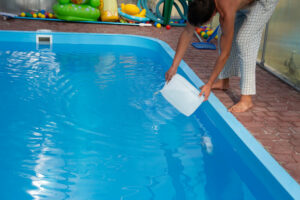
The Partial Drain and Refill Method: A Step-by-Step Guide
The Partial Drain and Refill Method is essentially a more targeted version of the dilution method. First, you need to determine the amount of water to replace, which depends on your current and desired CYA levels. Drain the appropriate volume of water from the pool, making sure not to damage the pool structure or equipment by reducing the water level too much.
After draining, refill the pool with fresh water, and then test the CYA levels again to ensure they’re within the desired range. This process may need to be repeated until the CYA levels are appropriately reduced.
The Bio-Active Cyanuric Acid Reducer: An Effective Solution
Bio-Active Cyanuric Acid Reducer is a product that uses a biological process to reduce CYA levels. The product contains microorganisms that break down Cyanuric Acid into by-products like nitrogen and carbon dioxide, which then escape into the atmosphere. This is a non-hazardous, eco-friendly method that doesn’t require draining or diluting pool water.
However, it’s important to follow the manufacturer’s instructions to ensure effective CYA reduction.
Understanding Reverse Osmosis for Cyanuric Acid Removal
Reverse Osmosis (RO) is a more advanced and efficient way to reduce CYA levels in pool water. This method involves pumping pool water through a semi-permeable membrane, which separates the water from impurities like Cyanuric Acid and other contaminants.
The purified water is then returned to the pool, and the concentrated waste is discarded. While this method can significantly reduce CYA levels, it requires specialized equipment and professional expertise, making it more expensive than other methods.
Professional Services for Cyanuric Acid Removal
If CYA levels are excessively high, or if you prefer not to deal with the process yourself, you can opt for professional pool services. These companies use various methods, including dilution, specialized chemicals, or advanced treatments like Reverse Osmosis, to efficiently reduce CYA levels.
They also have the expertise to adjust other chemical levels if needed, ensuring your pool water is safe and balanced. While this option can be more expensive, it offers convenience and peace of mind.
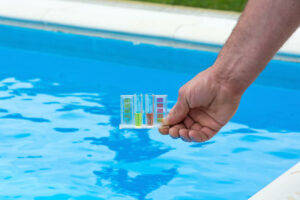
How to Use a Pool Water Rebalancer to Lower Cyanuric Acid Levels
Pool water rebalancers are products designed to restore the chemical balance of your pool water, including reducing high CYA levels. These products often work by neutralizing excess CYA, making chlorine more effective.
Using a rebalancer typically involves adding the product to your pool according to the instructions, allowing it to circulate, and then testing the water to ensure the CYA levels have dropped to the desired range. Make sure to follow the manufacturer’s guidelines for best results.
The Importance of Regular Maintenance to Control Cyanuric Acid
Regular maintenance is key to controlling Cyanuric Acid levels in your pool. This includes routine testing of your pool water to monitor CYA levels, timely adjustment of CYA concentrations, and careful selection of pool chemicals, opting for those that don’t contribute to CYA buildup if your levels are already high.
Regular maintenance not only prevents the problems associated with high CYA levels but also ensures a clean, safe, and enjoyable swimming environment.
Monitoring Your Pool After Cyanuric Acid Removal
Once you’ve reduced the Cyanuric Acid levels in your pool, continuous monitoring is crucial to prevent them from creeping back up. Regularly test your pool water, especially after heavy use, rainfall, or significant top-ups with new water. Adjust your chlorine and CYA inputs as necessary, based on the test results. This ongoing vigilance will help maintain a balanced, healthy pool and extend the lifespan of your pool equipment.
Frequently Asked Questions About Cyanuric Acid Removal
This section could answer common questions about Cyanuric Acid removal, such as “How often should I test my pool water for CYA?”, “What should I do if my CYA levels remain high despite treatment?”, or “Can I prevent high CYA levels?”. Addressing these FAQs can help pool owners feel more confident about managing their pool’s CYA levels and understand the importance of regular testing and maintenance.
Mistakes to Avoid When Reducing Cyanuric Acid Levels
Avoiding common mistakes can help ensure effective Cyanuric Acid removal. For instance, pool owners should avoid over-reliance on chlorine tablets or shock treatments that contain CYA, as these can contribute to accumulation.
Other mistakes to avoid include neglecting regular water testing, ignoring signs of high CYA levels, and failing to act promptly when levels are found to be high. Understanding and avoiding these mistakes can help maintain a healthy, safe pool environment.
Case Study: Real-Life Examples of Effective Cyanuric Acid Removal
Real-life case studies provide practical examples of how different methods of Cyanuric Acid removal have been successfully implemented. These examples could include situations where pool owners have used dilution, chemical treatments, or professional services to reduce their pool’s CYA levels. By sharing these experiences, pool owners can gain insights into the effectiveness of different strategies and understand what might work best for their circumstances.
Pool Maintenance Schedule: Keep Your Cyanuric Acid in Check
Keeping a regular pool maintenance schedule is crucial to control Cyanuric Acid levels. This should include weekly testing of the pool water, consistent monitoring of chlorine and CYA levels, and adjustments as needed.
It’s also recommended to shock your pool periodically, but be cautious about the products used, as some may contribute to CYA buildup. Additionally, consider seasonal changes, as warmer months with more sunlight may require more frequent adjustments.
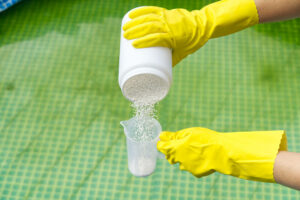
Final Thoughts: The Importance of Balancing Cyanuric Acid Levels in Your Pool
Balancing Cyanuric Acid levels is essential to maintaining a healthy, clean, and safe pool. While CYA plays a crucial role in protecting chlorine from sunlight, excessive levels can lead to several issues, including reduced chlorine effectiveness, cloudy water, and potential damage to your pool equipment.
Regular testing, proper maintenance, and understanding how to effectively reduce high CYA levels are all part of responsible pool ownership. With the right knowledge and tools, you can ensure your pool remains a fun and safe place for everyone to enjoy.

